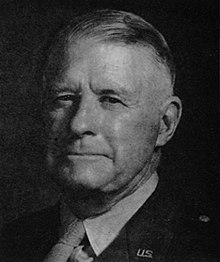Innis P. Swift
Innis Palmer Swift | |
|---|---|
 From the July 1954 edition of Assembly magazine | |
| Born | February 7, 1882 Fort Laramie, Wyoming, U.S. |
| Died | November 3, 1953 (aged 71) San Antonio, Texas, U.S. |
| Buried | Fort Sam Houston National Cemetery in San Antonio, Texas |
| Allegiance | United States |
| Service | United States Army |
| Years of service | 1904 – 1946 |
| Rank | Major General |
| Service number | 0-1969 |
| Commands | 1st Cavalry Division I Corps |
| Battles / wars | Philippine–American War Mexican Expedition World War I World War II |
| Awards | Distinguished Service Medal Legion of Merit Order of the Aztec Eagle (Mexico)[1] |
| Relations | Grandfathers: Major General Innis Newton Palmer Brigadier General Ebenezer Swift Father: Major General Eben Swift Brother in law: Brigadier General Evan Harris Humphrey |
Innis Palmer Swift (February 7, 1882 – November 3, 1953) was a Major General in the United States Army. He was the grandson and namesake of Civil War Major General Innis Newton Palmer,[2] as well as the grandson of Brigadier General Ebenezer Swift. His four decades of military service culminated in his commanding a unit during the liberation of the Philippines in World War II.
Early life and career
Swift was born at Fort Laramie, Wyoming, the son of Major General Eben Swift and Susan Palmer.[1] He graduated from West Point in 1904 and was commissioned in the cavalry. He served as aide-de-camp to General John J. Pershing in the Philippines[1] and then served in Mexico. While a First Lieutenant commanding C Troop, 13th Cavalry, he accompanied First Lieutenant George S. Patton on the hunt for Julio Cardenas, commander of Pancho Villa's personal bodyguard.[3] During World War I he served as Assistant Chief of Staff for the 86th Division.
Swift attended the Army Command and General Staff School, graduating in 1923, and remained at the school as faculty until 1929.[4] He subsequently attended the Army War College and the Army Industrial College
In 1940 he was promoted to Brigadier General, and in 1941 to Major General and placed in command of the 1st Cavalry Division and Fort Bliss.[5] He participated in the Louisiana Maneuvers, where he coined the nickname used by army light observation aircraft when he told a pilot after a bumpy landing, "You looked just like a damn grasshopper!"[6] [Editor's note: There are numerous versions of the story and it is uncertain as to exactly what Swift's words were. The author quoted (Graff) was paraphrasing]
World War II

He transitioned the division from horse cavalry to essentially an infantry division, though it retained "Cavalry" in the name. He took his division to Australia in July 1942 and remained in command through the Admiralty Islands campaign after which he was reassigned to command I Corps in August 1944. He led I Corps during the liberation of Luzon in the Philippines in late 1944 into 1945. He was the oldest U.S. Corps commander to serve in World War II.[4] After the war he remained a close personal friend of Douglas MacArthur.[7]
Private life and death

Swift married the former Lucille G. Paddock and the couple had four daughters. After retiring in 1946 he lived in San Antonio. He retained interest in his old command, staying active in the 1st Cavalry Division Association and avidly following the division's activity in Korea.[2] He died at Brooke Army Hospital after a heart attack and was buried in Fort Sam Houston National Cemetery.[1]
Notes
- ^ a b c d General Swift Taken by Death at San Antonio, El Paso Herald-Post, November 3, 1953, Page 1.
- ^ a b Gen. Swift, A Cavalryman, San Antonio Light, August 31, 1951, Page 21A.
- ^ D'Este, pp. 172-173.
- ^ a b Berlin, Robert H. “U.S. Army World War II Corps Commanders: A Composite Biography”. The Journal of Military History, Vol. 53, No. 2 (April, 1989), pp. 147-168.
- ^ Swift Quite a Gardener, San Antonio Light, December 12, 1947, Page 4B.
- ^ Graff, p. 109.
- ^ Gen. Swift Dies, Lubbock Evening Journal, Nov 3, 1953, Page 10.
References
- D'Este, Carlo (1996). Patton: A Genius for War. New York: Harper Collins. ISBN 978-0-06-092762-2.
- Graff, Cory (2003). Shot to Hell: The Stories and Photos of Ravaged WWII Warbirds. St. Paul, MN: MBI Publishing Co. ISBN 0-7603-1609-0.
